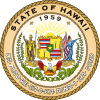Hawaiian language
| Hawaiian | |
|---|---|
| ʻŌlelo Hawaiʻi | |
| Region | Hawaiʻi: concentrated on Niʻihau and Hawaiʻi, but speakers throughout the Hawaiian Islands and the U.S. mainland |
| Ethnicity | Native Hawaiians |
Native speakers | 2,000 (1997)[1] to 24,000+ (2006–2008)[2] |
| Latin (Hawaiian alphabet), Devanagari, Hiragana, Katakana, Hangul, Mongolian/Manchu, Cyrillic | |
| Official status | |
Official language in | Hawaiʻi (with English) recognized as minority language in parts of: U.S. Mainland |
| Language codes | |
| ISO 639-2 | haw |
| ISO 639-3 | haw |
| ELP | Hawaiian |
The Hawaiian language (Hawaiian: ʻŌlelo Hawaiʻi) is the language of native Hawaiians. Aloha and mahalo are probably its most recognized words. The word lanai is also used in English. (That is different from Lanaʻi, the name of one of Hawaiʻi's islands.)
Related languages
[change | change source]There are related languages in the Marquesas, Raratonga, Samoa, some islands of what is now Fiji and New Zealand. Their languages have changed a lot over the last two thousand years or so. However, native speakers of all these languages can still understand each other.
Letters
[change | change source]The language has only 12 letters (A, E, H, I, K, L, M, N, O, P, U, W). There are 13 if you count the ʻokina. The ʻokina is a real letter and came from some "K" sounds in old Polynesian languages. The ʻokina is pronounced as a glottal stop, like the break in the middle of the word "Uh-oh". The ʻokina is written as a backward apostrophe (small numeral 6 above and before a vowel).
Dialects
[change | change source]The Niʻihau dialect still uses some T, S, R and "hints" of B sounds. People who live on that island are the only people who still speak Hawaiian only and their dialect is the truest to its roots.
Syllables
[change | change source]Every Hawaiian syllable ends with a vowel. There are some who think that makes the language sound "musical". Some think that final vowels helped the speakers remember chanted traditional stories and genealogies. Most linguists, however, think it is because of internal phonological processes.
There are two forms of each of the five vowels. One is regular, where the vowel is pronounced as a Spaniard would say it. The other is extended, in written form, where a horizontal bar called a kahako is over the vowel. The meanings (and pronunciations) of words spelled the same but with or without the appropriate kahakos or ʻokinas can be very different, sometimes even embarrassing.
Learning
[change | change source]One might think that learning the language would be relatively easy, but that only applies to na keiki (children) who have never learned the 26 letters that English speakers use. There is a children's rhyme that goes on for a couple of minutes (and written, probably a couple dozen lines) that consists of nothing but both versions of the letters a, i and the ʻokina. It talks of him (ia) eating (ai) his (iaia) fish (iʻa).
When the missionaries made a written form of Hawaiian Language, they did not write the kahakos or ʻokinas; leaving it to the context to make the meanings evident.
Since the intent was to translate the Bible ("Paipala"), natives forgave some of the confusion created. They still learned how unintended "double entendres" could be funny in written form. When Hawaiian language newspapers started, native-speaking writers and editors were careful to avoid these (the type that was available to "set" did not include such "specialty" characters).
References
[change | change source]- ↑ Lyovin (1997:258)
- ↑ U.S. Census (2010)

